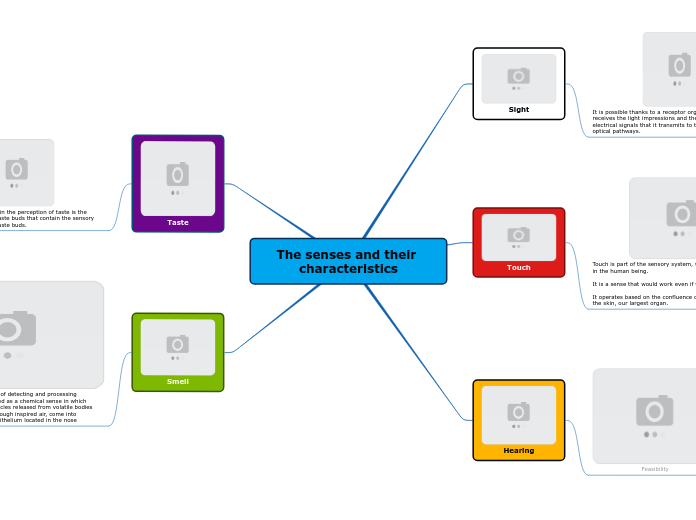The senses and their characteristics

Sight

It is possible thanks to a receptor organ, the eye, which receives the light impressions and the transformations into electrical signals that it transmits to the brain through the optical pathways.
in charge of interpreting our environment from the light that reaches our eyes
Through sight we receive approximately 50% of the information about our environment
Ej:

Your new dress looks great

Touch

Touch is part of the sensory system, which is permanently active in the human being.
It is a sense that would work even if we were deprived of others.
It operates based on the confluence of the nervous system and the skin, our largest organ.
Touch is essential for life. It constantly alerts us to the situation in which we find ourselves
It allows to perceive the qualities of objects and media, such as texture, pressure, temperature and hardness. It is also what allows us to feel certain stimuli that later turn into pleasure and pain.

Ej:This bed feels so soft

Hearing

Feasibility
The ear is a highly sensitive and advanced organ of the human body. The function of the ear is to transmit sounds to the brain through its different parts: the outer ear, the middle ear and the inner ear.
Its main task is therefore to detect, transmit and convert sounds into electrical impulses. Another important function is to maintain our sense of balance.
Our auditory system is responsible for converting the sound waves that surround us into information that our brain then processes and decodes. Information that often moves us: music, nature, words ...
Ej:

This song sounds very horrible, take it off!

Taste

The main organ involved in the perception of taste is the tongue. It is covered in taste buds that contain the sensory receptors for taste: the taste buds.
The sense of taste mainly includes the perception of five taste modalities, which have differentiated receptors. Said modalities are the four already known: sweet, bitter, salty and acid, to which is added a fifth recently discovered and little specified, unami (which is associated with sodium monoglutamate present in some foods).
Taste is the sense that allows us to identify flavors in food

Ej:
This palette tastes so sweet

Smell

Smell is the sense in charge of detecting and processing odors. Smell has been defined as a chemical sense in which aromatic or odoriferous particles released from volatile bodies act as stimulants, which, through inspired air, come into contact with the olfactory epithelium located in the nose
Dogs are animals that are quite guided by smells.
Smell is a good defense system to tell us how our environment is: if it is clean, dirty, if there is a threat or if it is safe to stay there.
Ej:
This flower smells very nice
